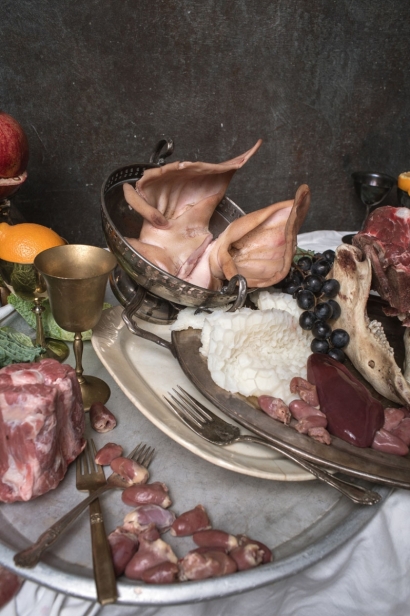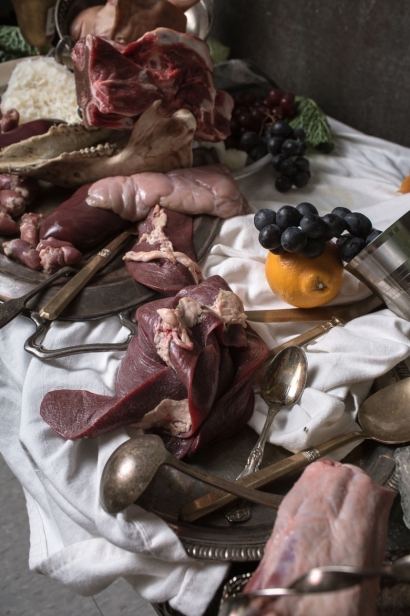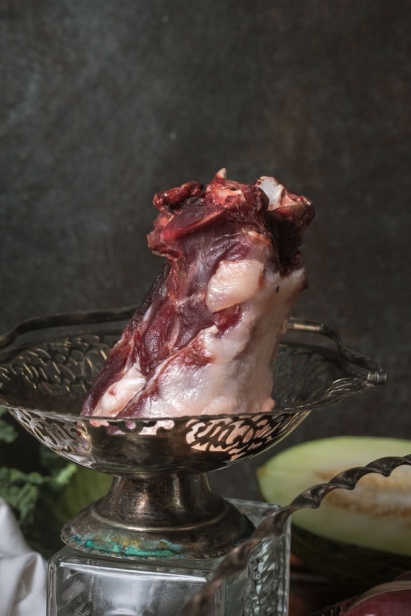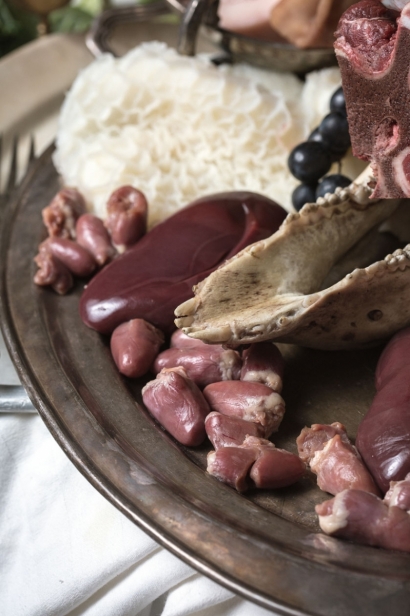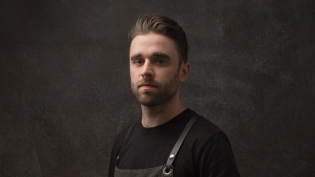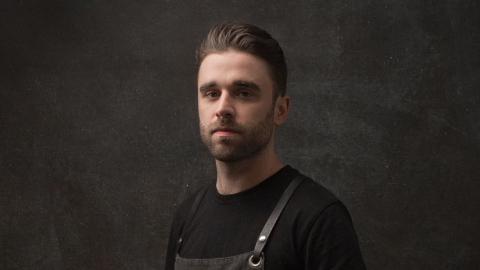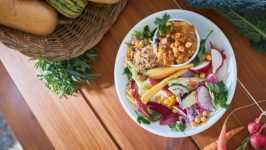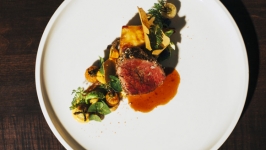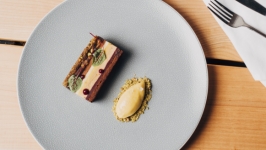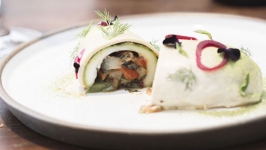The Odd Bits
In an age where #avocadotoast and unicorn-coloured treats are at the top of the food-trend chain, perhaps it’s not surprising that innards don’t see a lot of love. At the same time, awareness of how eating habits affect our bodies and our planet is growing. Why then, do we eschew these sources of protein and waste valuable parts of a butchered animal?
Once revered as the choice parts of an animal, offal — the internal organs, and other odd bits, from ears, to tails and other extremities — is now often eyed with squeamish skepticism. Historically, offal and the odd bits were key components of culinary lexicons around the world. To this day, many cultures have traditional, well-loved specialties that feature the innards. Today’s North American cuisine? Not so much.
At various times, offal has been the food of royals and peasants. In ancient times, these were the prized parts for diners in the upper echelons of society: from liver to spleen, heart and brain, these were the first pieces of the animal to go. There were fewer of these parts than regular animal meat, making them more desirable. Over time, they fell out of fashion. During the Second World War rationing was required; prime cuts of meat were expensive and harder to come by. Offal was an affordable source of protein, helping to stretch meals and budgets. Once the post-war boom arrived, offal was out again; seen as food for the lower class. Sweetbreads were out, steaks were in.
Now, food is the cheapest it has ever been. Convenience is often the name of the game and skinless, boneless, cuts of plasticwrapped meat are at the fingertips of grocery shoppers. Offal is unfamiliar and strange to many — though they may have grandparents who speak fondly of liver and onions, or fighting over turkey gizzards at Christmas time, it’s not something they eat or cook regularly, if ever.
But, the nose-to-tail style of cooking that came on to the scene in the last couple of decades has proven to be more than just a buzzword for many chefs and diners. Whether cooking family recipes or putting modern twists on traditional dishes, more and more chefs are embracing making use of all parts of the animal.
Cezin Nottaway jokes that the word itself, offal, might be putting diners off: it sounds… well, awful. Nottaway is the owner and chef behind Wawatay Catering, offering Indigenous cuisine to the Ottawa-Gatineau region. “In my culture, we call those parts delicacies,” she explains. And when described as a delicacy instead of offal, “people’s eyes light right up.”
Originally from La Verendrye, one of the first times Nottaway came to Ottawa was as a kid on a school trip to skate on the Rideau Canal. She and her friends quickly noticed the signs for beaver tails and she remembers thinking, “Wow, I didn’t know non-Indigenous people ate beaver tails!” — only to be further surprised when she found out the tail in question was actually sugary, fried dough. Though there’s not typically enough of it to put offal and odd bits on her catering menu, beaver tail (the real thing, not the sweet treat) is one of the traditional dishes that Nottaway offers to teach workshop participants. She does it the way her grandmother has always prepared it: boiled until the fibres are broken down and tender, then sautéed in compound herb butter with maple syrup. The end result, Nottaway says, is like “crispy bacon with a wildness to it.”
Nose-to-tail isn’t a novel way to cook for Nottaway; in traditional Algonquin cooking, nothing is wasted. Nottaway attributes today’s shyness to offal to a lack of exposure — pointing out that people will happily munch away at mysterious processed foods from a certain establishment with golden arches, but are afraid to try natural products that are unfamiliar.
With dozens of Vietnamese restaurants in Ottawa serving up steaming bowls of pho, Ottawans are likely familiar with the meaty options — odd or otherwise — to go in the bowls of beef broth and noodles. There’s rare beef (bo tai), brisket (gan), meatballs (bo vien), and even tendon (gan). Huong Nguyen’s favourite addition? Tripe (sach). Nguyen, chef and owner of Huong’s Vietnamese Bistro in Ottawa’s Chinatown, has been preparing the well-known soup for hungry diners for almost a decade.
Beef tripe (the muscle wall of a cow’s stomach) is a mild tasting cut and doesn’t impart much flavour to the soup — it absorbs the broth seasoning as it simmers. It fulfills more of a textural role, adding something to slurp on with the noodles. Not only popular amongst guests at the bistro, Nguyen says it’s something that she grew up eating and that she serves to her family every day.
Hunter Little didn’t grow up eating offal, but his enthusiasm for cooking the “odd bits” is contagious these days. He fell in love with the nose-to-tail ethos while working at a restaurant in Montreal (where, he admits, diners seem keener to try the off cuts than in the capital region). To pursue his passion, he worked at a nose-to-tail butcher shop. The shop only received the full animal, so he learned how to break them down and use each part.
Now cooking at Riviera, one of Ottawa’s newest and busiest restaurants, Little dedicates four days a week to butchery and charcuterie. His focus is on the French style of charcuterie (such as rillettes, terrines and pâtés), but you might also find things like pig head macaroni, or coppa, an italian-style coldcut on the menu on any given day.
Though in-house butchering and charcuterie can be challenging, Little says it’s great for his own development as a chef, and touts the economical and sustainable benefits to using the whole animal. It’s a win-win-win, for him, the restaurant, and diners.
Like Little, Elliot Reynolds often turns to the canon of classic French charcuterie when he cooks with offal. At the helm of the kitchen at The Hubb, in Prince Edward County, Reynolds echoes the economic argument for offal — “you know how to use more ingredients on your menu,” which increases the options for the kitchen, and in turn what’s available for customers. Though diners can sometime be a little shy about ordering offal, Reynolds says he gets a kick out of seeing them enjoy something they might not have initially thought to try. There’s the occasional main dish featuring offal,but Reynolds likes to frame his offal dishes primarily as bar snacks, keeping things accessible and familiar. With The Hubb’s sommelier (and Reynolds’ wife), Laura Borutski, he works to showcase some of the county’s best wine and beer with snacks such as crispy pig ears or fried sweetbreads.
Neither Little nor Reynolds cooked much with offal and odd bits prior to their careers, but they both say it’s about keeping things simple. Little suggests that home cooks try a dish they’d like to cook at a restaurant first, to get an idea of what the finished product might be like. His favourite thing to make at Riviera is pâté en croûte — an “old-school” recipe of pâté in a crust of flaky pastry dough and a layer of gelée. Though it’s time-consuming (“a labour of love” according to Little), it’s versatile and packs a lot of flavour into one appetizer. A more simple country pâté (picture a richer, more decadent meatloaf) with inexpensive meat cuts is the “perfect gateway” to cooking with offal, Little suggests. It’s not difficult to make, but does require some planning, and, of course, the better the ingredients, the better the result. Some odd bits can be found at the grocery store, but chefs recommend checking in with your local farmers or butcher shops.
At Around the Block Butcher Shop, in Ottawa’s west end, whole animals are often butchered, but offal is hit or miss when it comes to sales. Owner and head butcher David Wallace has found that lamb and beef liver are in highest demand, with turkey gizzards going “mighty quick at seasonal turkey times.” Wallace tends to see two different types of customers coming in to buy offal and odd bits: those who are keen to spend time on “refined culinary techniques” and others who keep to more casual recipes.
Unless we see a “full blown economic collapse,” Wallace doesn’t think offal will ever make a comeback to the collective mainstream diet. But if food trends are cyclical, perhaps we’ve come back to a time where offal and odd bits are treated less like distasteful remnants and more like the prized parts they once were. It’s not hard to find restaurants that are making their own charcuterie and using all the parts of the animal isn’t considered revolutionary in most culinary circles. With recipes rooted deep in tradition receiving modern attention and the case for sustainable eating — both environmentally and economically — at the forefront, in many ways, offal is looking awfully good.
Around the Block Butcher
1117 Cobden Rd., Ottawa, Ont.
aroundtheblockbutchershop.com, 613.820.3258
Huong’s Vietnamese Bistro
359 Booth St., Ottawa, Ont.
613.237.8755
The Hubb
433 Main St., Bloomfield, Prince Edward County
angelines.ca, 613.393.3301
Riviera
62 Sparks St., Ottawa, Ont.
dineriviera.com, 613.233.6262
Wawatay Catering
13 Wanaki, Maniwaki, Qué.
wawataycatering.com, 819.441.1111



